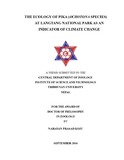Please use this identifier to cite or link to this item:
http://archive.nnl.gov.np:8080/handle/123456789/326| Title: | The ecology of Pika (Ochotona species) at Langtang National Park as an indicator of climate change |
| Authors: | Koju, Narayan Prasad |
| Keywords: | Pika--Nepal Pika--Langtang National Park Pika |
| Issue Date: | 24-Dec-2018 |
| Abstract: | Pikas are small mammal related to rabbit and hare that inhabit in rocky talus field in higher elevated alpine area. The Himalayas are only habitats of pika in Nepal. The study was carried out in transect of 53 km length and 200 m wide along the trails in two routes of Langtang National Park (LNP), Nepal from 2011 to 2014. Total fifty permanent quadrats of 50m x 50 m were plotted to study pika abundance and their behaviour in LNP. The observation was done for six times in different seasons. Within these quadrats, small quadrats of 20m x 20m were used to calculate tree, 5m x 5m quadrat for shrub and 1m x 1m for ground vegetation. The behaviour in 459 hours were recorded by focal scan sampling methods at interval of one minute. Grooming, musing, calling, feeding, foraging, chasing, resting inside burrow and galloping behaviour were observed as general behaviour and some special behaviour like mate (mounting), drinking water, defection of pellets, parental care were also recorded. Camera traps were used to record nocturnal behaviour, and Spring traps and Sherman traps were used to capture the pikas. Six most consumed (in frequency) plants were collected from different elevations. Nutrients like protein, Calcium, Phosphorus, Potassium, Total ash, moisture contain, Cellulose, Hemi-cellulose, Acid Detergent Lignin and Neutral detergent fiber were analyzed from those forage plants. Meteorological data of maximum temperature, minimum temperature, humidity and rainfall were analyzed that were collected from Department of Hydrology and Meteorology (DHM), Kyanging (3900m) station for 1983 to 2012. Eighteen temperature data loggers (DS1921G Thermochron iButtons) were installed in pika habitat at 200m altitudinal gradient. 1-Wire Drivers X86 software was used to download data from iButtons. Statistical analysis was done using Excel, R software and SPSS. GIS was used for mapping habitat and population of different pika species. Only Large eared pika (Ochotona macrotis) and Royle’s pika (Ochotona. roylei) were found in Langtang National Park during observation. They both have broadly similar morphology and use same habitat. The average body length O. roylei was 138.5 ± 0.64 mm and O. macrotis 152± 1.08mm. Habitat of pikas was categorized into three parts: forest, subalpine and alpine. During six field works, 674 pikas were observed. The population density of O. roylei was 4.8 /ha in forest and its edge area, 12.13/ha in subalpine area and 7.86/ha in alpine talus area. The O. macrotis had the population density 8.8/ha in subalpine area and 10.47/ha in talus alpine area. There was no significant relation between population distribution of pikas and their age category in subalpine area and alpine area but population density of O. roylei was significantly less (p value=0.014) in forest and its edge. Similarly, there was no significant difference between behaviour of adult O. macrotis and adult O. roylei, and with their respective juveniles but the seasonal behaviour was significantly different in both the species (p value=0.011). In the study area, there were 65 plants species as ground vegetation. Pikas consumed 58 plants species. Fifteen species of plants were consumed in all four habitats, twenty-four species of plants were consumed by pikas in three habitats, three species of plants were consumed in two habitats and sixteen species of forage plants and their parts were consumed only in one habitat. Pikas showed the characters of coprophagous as well as geo-phagous. Pollutants especially plastic, paper, clothes, bottles, used batteries and other non-degradable wastes are affecting activities of pikas in Gosainkunda region. The mean minimum temperature of Langtang National Park was increasing significantly in all seasons and months but mean maximum temperature had no significant change with time. The temperature of mid elevation of the study areas (3300 m to 3600 m) was almost constant. The temperature inside the burrows in these areas was cooler in hot summer and warmer in cold winter, and seems favorable for pika’s survival. The temperature of higher elevation (above 3900 m) was warmer than lower elevation in summer and very colder in winter. There was 0.640C/100 m change in temperature from elevation of 3000 masl to 3500 masl. Similarly, the change in temperature were 0.460C/100 m from 3500 masl to 3980 masl and 0.4530C/100 m from 3980 masl to 4600 masl. Pikas in Langtang were encountered not below 3000 m; this is 200m elevation above in the interval of two decades, indicating that they have either migrating upward or locally extinct at reported lower elevation. The number of days with temperature less than -50C is increasing in winter, thus, pikas in Langtang National Park, Nepal are under threat of acute cold stress caused by increase in mean minimum temperature in reference to climate change. |
| Description: | A thesis submitted to the Central Department of Zoology, Institute of Science and Technology, Tribhvan University, Nepal, for the award of Doctor of Philosophy in Zoology, 2014. |
| URI: | http://103.69.125.248:8080/xmlui/handle/123456789/326 |
| Appears in Collections: | 500 Natural sciences and mathematics |
Files in This Item:
| File | Description | Size | Format | |
|---|---|---|---|---|
| Narayan Koju.pdf | 5.32 MB | Adobe PDF |  View/Open |
Items in DSpace are protected by copyright, with all rights reserved, unless otherwise indicated.